 On the first of January 2017 the transition period for amendments to twenty-eight Acceptable Solutions and ten Verification Methods started. During the transition you can use the old version or the new amended version. However on the 30th May 2017 most of the amendments will become compulsory and only the new amended versions can be used.
On the first of January 2017 the transition period for amendments to twenty-eight Acceptable Solutions and ten Verification Methods started. During the transition you can use the old version or the new amended version. However on the 30th May 2017 most of the amendments will become compulsory and only the new amended versions can be used.
The exception to this is NZBC D2/AS1 which has a longer transition period until 6th August 2017.
Summary of changes
The following is a brief description by MBIE (called Acceptable Solutions and Verification Methods Amendments 2016) of the changes to each Acceptable Solution or Verification Method, with a few additional Masterspec Notes  and Masterspec links
and Masterspec links  to more detailed Masterspec information.
to more detailed Masterspec information.
B1 Structure: B1/AS1, B1/VM1, B1/VM4 (Amendment 15)
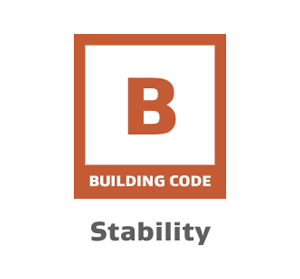 The modification in B1/VM1 on applying the hazard factor Z, to buildings with structure periods less than 1.5 seconds in the Canterbury earthquake region, is deleted.
The modification in B1/VM1 on applying the hazard factor Z, to buildings with structure periods less than 1.5 seconds in the Canterbury earthquake region, is deleted.- The modification in B1/VM1 on applying a minimum risk factor for the serviceability limit state of Rs = 0.33 in the Canterbury earthquake region is deleted.
- Clause 9.3.9.4.13 in NZS 3101 is modified in B1/VM1 to limit the depth of precast units to 300 mm and the overall depth to 400 mm.
- The formula in B1/VM4 paragraph 3.3.2b) is corrected.
- NZS 4223 Parts 1 to 4 are updated to the latest versions in B1/AS1, and the structural glass barrier requirements in Part 3 are modified.
- Clause 7.4.1.3 and Figures 7.10(b) and 7.10(c) in NZS 3604 are modified to clarify the requirements (in accordance with the latest test data).
 For more information on NZS 4223 and NZS 3604 updates)
For more information on NZS 4223 and NZS 3604 updates)
B2 Durability: B2/AS1 (Amendment 9)
- NZS 4223.2:2016 is cited as a means of compliance for the durability of insulating glass units (IGU's) (double glazing)
 - For more information on NZS 4223 updates)
- For more information on NZS 4223 updates)
C1-C6 Protection from fire: C/AS1 to C/AS7 (Amendment 4) 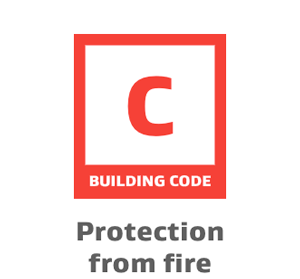
- Paragraph 1.1.2, C/AS2 to C/AS6: Clarification that an alternative solution or Verification Method can be used for buildings with complex features or specific fire engineering design.
- Paragraph 2.3, C/AS1 to C/AS7: Scope limitations on Life rating and Property rating are removed.
- Paragraph 3.4, C/AS1 only: NZS 4514 domestic smoke alarms can be used to extend travel distance in housing.
 In the related Table 3.2, NZS 4514 was cited previously so this has been theoretically possible for some time).
In the related Table 3.2, NZS 4514 was cited previously so this has been theoretically possible for some time).
-
Paragraph 3.15.5.b), C/AS3 only: Door widths clarified.
- Paragraph 4.1.3, C/AS7 only: Limitations on intermediate floors do not apply to car parks.
 - New clause, applies if cross ventilation or sprinklers are provided)
- New clause, applies if cross ventilation or sprinklers are provided)
- Paragraph 4.9.6, C/AS2 only: Paragraph removed as requirements are given in Paragraph 3.9.6.
- Paragraph 4.16.12, C/AS3 and C/AS4: Location of smoke dampers clarified.
- Paragraph 5.1.2, C/AS1 only: Requirement for notional boundary between buildings only applies where there is sleeping use.
- Paragraph 5.5.7, C/AS2 to C/AS6: The tabulated method for calculating Unprotected Areas can be used.
 - New clause, allows the alternative of using Appendix A from the Commentary to C/VM2. Although MBIE say this includes C/AS6, there is no paragraph 5.5.7 in the current amended version of C/AS6?).
- New clause, allows the alternative of using Appendix A from the Commentary to C/VM2. Although MBIE say this includes C/AS6, there is no paragraph 5.5.7 in the current amended version of C/AS6?).
- Paragraph 5.8.3, C/AS2, C/AS4 to C/AS6: Removed dispensation from external cladding requirements for buildings sprinklered and less than 25m.
 - For more information on the new restrictions on combustible external cladding.
- For more information on the new restrictions on combustible external cladding.
- Appendix C, C/AS2 to C/AS6: Table added enabling Australian and European Standards to be used to determine Group Numbers.
 - This new Table C1 adds the alternative Standards AS ISO 9705 and EN 13501.1, which formalises the use of these alternatives. Masterspec was already partly using these Standards.
- This new Table C1 adds the alternative Standards AS ISO 9705 and EN 13501.1, which formalises the use of these alternatives. Masterspec was already partly using these Standards.
 - Although there are a lot of amendments under NZBC C, the affect on Masterspec Sections was quite minor. However, the affect on design could be major in some cases, so check the latest version of the Code for your project requirements.
- Although there are a lot of amendments under NZBC C, the affect on Masterspec Sections was quite minor. However, the affect on design could be major in some cases, so check the latest version of the Code for your project requirements.
D1 Access routes: D1/AS1, D1/VM1 (Amendment 6)
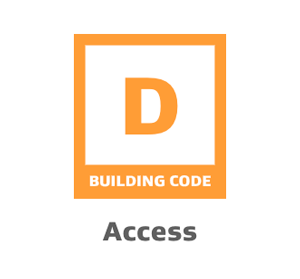 Section 2.1 on slip resistance of walking surfaces is revised and references AS 4586: 2013 ‘Slip resistance classification of new pedestrian surfaces’.
Section 2.1 on slip resistance of walking surfaces is revised and references AS 4586: 2013 ‘Slip resistance classification of new pedestrian surfaces’.
 - This is a major change
- This is a major change
 - For more information on the new slip resistance and AS 4586
- For more information on the new slip resistance and AS 4586
- Paragraph 1.2.1 includes a requirement for maximum vertical variations in flooring.
- BS EN 14975: 2006 ‘Loft ladders – Requirements, marking and testing’ is referenced as an acceptable solution.
- AS 1657: 2013 ‘Fixed platforms, walkways, stairways and ladders – Design, construction and installation’ replaces an earlier version.
- Minor changes and corrections are made throughout the text for clarity.
 - Masterspec sections have been updated for the changes to slip resistance requirements and testing to suit AS 4586. Updates also cover changes to access routes for service and maintenance personal.)
- Masterspec sections have been updated for the changes to slip resistance requirements and testing to suit AS 4586. Updates also cover changes to access routes for service and maintenance personal.)
 - For more information on the new slip resistance and AS 4586
- For more information on the new slip resistance and AS 4586
D2 Mechanical Installations for Access: D2/AS1 (Amendment 7)
- The lift Standard EN 81-20:2014 is cited, with appropriate modifications for use in New Zealand, to incorporate modern technology and practices. The longer transition period for introducing EN 81-20 aligns with its introduction internationally.
 - Major Standard change but longer transition, mandatory 6th August 2017
- Major Standard change but longer transition, mandatory 6th August 2017
E1 Surface Water: E1/VM1 (Amendment 10)
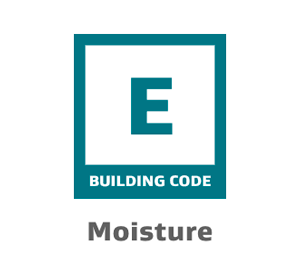 Six reference Standards are updated.
Six reference Standards are updated.- Minor corrections are made to Table 1 and paragraph 9.0.6.
 - 9.0.6 changes a formula for calculating soak pit volume [which seems to provide the same answer as the old formula?
- 9.0.6 changes a formula for calculating soak pit volume [which seems to provide the same answer as the old formula?
E2 External Moisture: E2/AS3 (Amendment 7)
- The code of practice CCANZ – CP 01: 2014 errata 1 January 2015 replaces the 2014 version.
E3 Internal Moisture: E3/AS1 (Amendment 6)
- Comment under paragraph 1.1.4 is corrected – clause E3 does not apply to buildings that are not Housing or Communal residential.
F2 Hazardous Building Materials: F2/AS1 (Amendment 3) 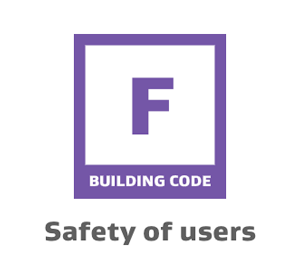
- NZS 4223.3: 2016 Amendment 1 ‘Glazing in buildings – Human impact safety requirements’ replaces the 1999 version.
- A comment is provided on asbestos in building materials.
F4 Safety from Falling: F4/AS1 (Amendment 2)
- Minor changes to Table 1 regarding barriers on stairways.
- A comment is provided on access to building services equipment mounted on roofs.
- Requirements for opening windows are clarified in section 2.0.
 - There are a number of items worth noting, but in particular the new requirement that if a window is within 500mm horizontally of a toilet or other fixed feature, the lower edge permissible height is measured from the pan or feature.
- There are a number of items worth noting, but in particular the new requirement that if a window is within 500mm horizontally of a toilet or other fixed feature, the lower edge permissible height is measured from the pan or feature.
F6 Visibility in Escape Routes: F6/AS1 (Amendment 4)
- Comments are modified to improve guidance on “occupant load” and “slopes”.
F8 Signs: F8/AS1 (Amendment 4)
- AS/NZS 2293.2 is updated to the latest version and NZS 4541 is cited.
- Exit signs, sprinkler signage and electromagnetic compatibility are clarified (paragraphs 4.5.1, 5.4 and Appendix A respectively).
 - This includes "Storage Height Indicators" [signs] to NZS 4541.
- This includes "Storage Height Indicators" [signs] to NZS 4541.
- Suitable LED lighting is included as an acceptable means to recharge photoluminescent signs.
 - Masterspec sections 7743 EMERGENCY EVACUATION LIGHTING and 5811 SIGNS & DISPLAYS, have been updated to suit.)
- Masterspec sections 7743 EMERGENCY EVACUATION LIGHTING and 5811 SIGNS & DISPLAYS, have been updated to suit.)
G2 Laundering: G2/AS1 (Amendment 3) 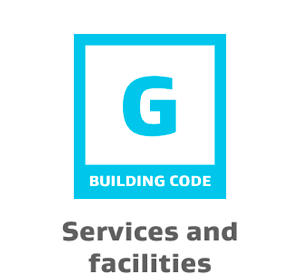
- The reference to AS/NZS 1229:2002 is corrected.
- The minimum space requirements for laundries and laundries for persons with disabilities are clarified (paragraph 1.2 and Figures 1 and 2).
G3 Food Preparation and Prevention of Contamination: G3/AS1 (Amendment 2)
- The minimum clear area for domestic kitchens and the associated requirements for facilities for persons with disabilities are clarified in G3/AS1 (Figure 1 and paragraphs 1.5.1 and 1.5.2).
 - For certain situations minimum kitchen dimensions have been reduced.
- For certain situations minimum kitchen dimensions have been reduced.
G4 Ventilation: G4/AS1, G4/VM1 (Amendment 4)
- AS/NZS 5601.1:2013 and the Workplace Exposure Standards are updated to the latest versions, including consequential changes to G4/AS1 paragraphs 2.4.1(c) and 3.0.1.
 - For more information on AS/NZS 5601.1 and the affect on G4, G10 and G11
- For more information on AS/NZS 5601.1 and the affect on G4, G10 and G11
G10 Piped Services: G10/AS1, G10/VM1 (Amendment 8)
- AS/NZS 5601.1:2013 is updated to the latest version, including consequential changes to G10/AS1 paragraph 5.0.1.
 - For more information on AS/NZS 5601.1 and the affect on G4, G10 and G11
- For more information on AS/NZS 5601.1 and the affect on G4, G10 and G11
G11 Gas as an Energy Source: G11/AS1 (Amendment 6)
- AS/NZS 5601.1:2013 is updated to the latest version.
 - For more information on AS/NZS 5601.1 and the affect on G4, G10 and G11
- For more information on AS/NZS 5601.1 and the affect on G4, G10 and G11
G12 Water Supplies: G12/AS1, G12/AS2, G12/VM1 (Amendment 10)
- Eight referenced Standards for pipe materials, design and installation, including AS/NZS 3500.1 and AS/NZS 3500.4, are updated to the latest versions and BS EN 1567:1999 is referenced.
- Minor corrections, clarifications and consequential changes from updating Standards are made to G12/AS1 and G12/AS2.
 - For more information on AS/NZS 3500 and the affect on G12 and G13)
- For more information on AS/NZS 3500 and the affect on G12 and G13)
G13 Foul Water: G13/AS1, G13/AS2, G13/AS3, G13/VM2 (Amendment 6)
Five referenced Standards for pipe materials, design and installation, including AS/NZS 3500.2, are updated to the latest versions and consequential changes are made to G13/AS1, G13/AS2 and G13/AS3.
Minor changes are made in G13/AS1 relating to air admittance valves.
(mslink-icon - For more information on AS/NZS 3500 and the affect on G12 and G13)
G14 Industrial Liquid Waste: G14/VM1 (Amendment 6)
Four referenced Standards for pipe materials and installation are updated to the latest versions.
H1 Energy Efficiency: H1/AS1, H1/VM1 (new Fourth Edition)
CodeH-img
NZS 4218:2009 replaces the 2004 version in H1/AS1 and H1/VM1.
Overall the requirements in H1/AS1 do not change, but foil insulation is no longer within the scope of H1/AS1.
(mslink-icon - For more information on the changes to H1 and the affects of the new NZS 4218)